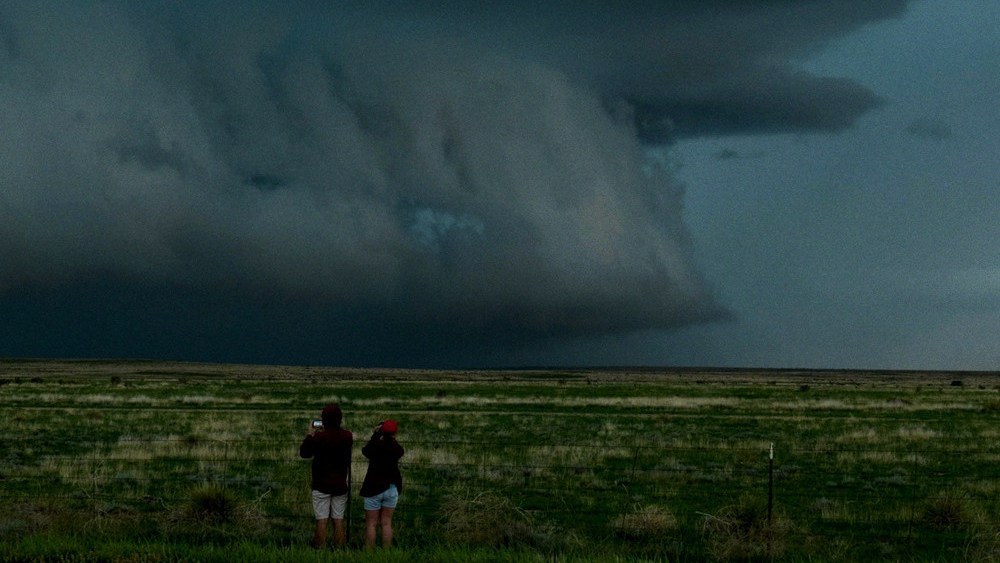From Dorothy’s home getting caught in a wild wind storm in 1939’s “The Wizard of Oz” to Helen Hunt and Bill Paxton running toward danger in 1996’s “Twister,” the tornado has long permeated American screen culture. With “A Brief History of Chasing Storms,” filmmaker Curtis Miller adds to this tradition with a comprehensive study of the iconic phenomenon.
Premiering at Swiss documentary festival Visions du Réel, Miller’s film explores the mythology around the tornado in a road movie that crisscrosses the region of the American Midwest known as the “Tornado Alley.” Through visiting several towns in the region and speaking with its tornado-enthusiast inhabitants, the filmmaker traces the history of the country in parallel with that of the weather condition. Speaking with Variety ahead of the world premiere, Miller recalls always having had an interest in tornadoes, thanks to growing up in a region of Oklahoma often affected by the storms.
“I was interested in the way tornadoes have a unique visual history,” adds the director. “They are highly documented and very photogenic, so I was often thinking about this relationship and in 2021, after the pandemic, I spent about three weeks doing site visits and research. I tried to remain pretty open to where the film would develop, so I spent the next three summers going back during peak storm season, even doing a little storm-chasing myself.”
One of the key things that led Miller to pursue the project was the potential of broaching wider historical questions on the making of the United States from the jump point of the tornado. “A topic like this one can hopefully allow the audience to start noticing the implications of settler colonialism and housing segregation,” says the director. “History is intertwined and messy. In Woodward, Oklahoma, there were huge, vivid murals illustrating the settler past of the region in the Cherokee Strip. Those land runs were reenacted by high schoolers up until recently as part of this founding myth.”
Matt and his storm-chasing car, courtesy of Curtis Miller
There is also, of course, the potential to explore the relationship between the tornado and pop culture, although Miller says that at the time he began working on “A Brief History of Chasing Storms,” he did not know about Lee Isaac Chung’s sequel of the 1996 blockbuster, “Twisters.” There is, however, a coincidence that unites both films: Matt, the storm chaser featured in Miller’s documentary, lent his iconic storm chasing vehicle to Chung’s production. The converted taxi cab shows up briefly in the background of one of the scenes.
“There’s a dialogue scene at a motel where you can very briefly see his car, and Matt is very proud of that. I think he is actually more excited about the few seconds he has on that film than the whole chapter he has on mine,” jokes Miller.
There was a point where the director thought about the possibility of making a film about the culture of storm chasing itself, but he felt “a lot of that has already been explored.” What he did find fascinating was hearing more about how films such as “Twister” and “Wizard of Oz” have come to shape and influence the storm-chasing community.
“During my research, I learned about the role of these popular movies in the origin stories of storm chasers,” Miller points out. “These are people who dedicate their lives to it and see it reflected back to them in a Hollywood way, which they cherish. The culture already existed before the film, but ‘Twister’ changed the way people thought of themselves as storm chasers. One of the things that came up when I interviewed chasers is how they all have particular ‘Twister’ characters they align with the most, and they use them as means of identification.”
Conversely, there is also a present sense of trepidation when studying the history of tornadoes, especially when taking in consideration the effects of global warming in extreme weather. Miller, who grew up in an area “where tornado warnings were pretty commonplace,” now sees friends from much tamer regions of the country start growing concerned about climate instability.
“People who come from environments where the weather patterns are less chaotic now have very legitimate anxieties about increased climate uncertainty,” says the filmmaker. “One of the things I was interested in was how not only will we live within that framework but how are people already doing it? People in these regions already live under weather extremes, so how have they learned to persist in this environment?”
The director cites the ongoing debate about whether or not the Tornado Alley region is shifting to the East or growing larger. “There’s a theory that storms are going to be less frequent but continue to get stronger. It’s quite scary that winds are currently measuring as high as 300 miles per hour. Very few buildings can survive something like that. How do we prepare for such a future?”
